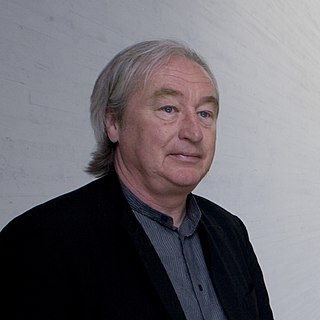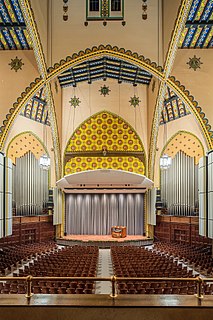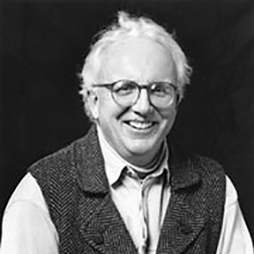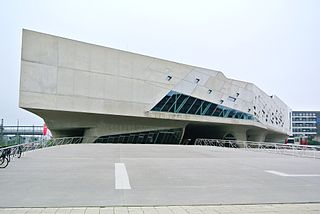Related Research Articles

Robert Charles Venturi Jr. was an American architect, founding principal of the firm Venturi, Scott Brown and Associates, and one of the major architectural figures of the twentieth century.
The year 1972 in architecture involved some significant architectural events and new buildings.

Postmodern architecture is a style or movement which emerged in the 1960s as a reaction against the austerity, formality, and lack of variety of modern architecture, particularly in the international style advocated by Philip Johnson and Henry-Russell Hitchcock. The movement was introduced by the architect and urban planner Denise Scott Brown and architectural theorist Robert Venturi in their book Learning from Las Vegas. The style flourished from the 1980s through the 1990s, particularly in the work of Scott Brown & Venturi, Philip Johnson, Charles Moore and Michael Graves. In the late 1990s, it divided into a multitude of new tendencies, including high-tech architecture, neo-futurism, new classical architecture and deconstructivism. However, some buildings built after this period are still considered post-modern.

Steven Holl is a New York-based American architect and watercolorist. Among his most recognized works are the 2019 REACH expansion of the John F. Kennedy Center for the Performing Arts, the 2019 Hunters Point Library in Queens, New York, the 2007 Bloch Building addition to the Nelson-Atkins Museum of Art in Kansas City, Missouri, and the 2009 Linked Hybrid mixed-use complex in Beijing, China.

Deconstructivism is a movement of postmodern architecture which appeared in the 1980s. It gives the impression of the fragmentation of the constructed building, commonly characterised by an absence of obvious harmony, continuity, or symmetry. Its name is a portmanteau of Constructivism and "Deconstruction", a form of semiotic analysis developed by the French philosopher Jacques Derrida. Architects whose work is often described as deconstructivist include Zaha Hadid, Peter Eisenman, Frank Gehry, Rem Koolhaas, Daniel Libeskind, Bernard Tschumi, and Coop Himmelb(l)au.

Denise Scott Brown is an American architect, planner, writer, educator, and principal of the firm Venturi, Scott Brown and Associates in Philadelphia. Scott Brown and her husband and partner, Robert Venturi, are regarded as among the most influential architects of the twentieth century, both through their architecture and planning, and theoretical writing and teaching.

Irvine Auditorium is a performance venue at 3401 Spruce Street on the campus of the University of Pennsylvania, in Philadelphia. It was designed by the firm of prominent Philadelphia area architect Horace Trumbauer and built 1926–1932. Irvine Auditorium is notable for its nearly 11,000-pipe Curtis Organ, the world's 22nd-largest pipe organ, originally built for the Sesquicentennial Exposition of 1926 and donated to the university in 1928. The building was opened in May, 1929.
Interest in the Architecture of Las Vegas began in the late 1960s, when in 1967 architects Robert Venturi and Denise Scott Brown traveled to the city accompanied by students in order to study its architecture. They wrote, with Steven Izenour, a report in 1972 on the subject entitled Learning From Las Vegas: the Forgotten Symbolism of Architectural Form. This report, and its thesis that Las Vegas showed the way for architecture in the late 20th century, drew the attention of the architectural world to the city. A quarter of a century later, for a BBC program Venturi and Scott Brown revisited the city, and revised their opinions.

The Big Duck is a ferrocement building in the shape of a duck located in Flanders, New York, on Long Island. It was originally built in 1931 by duck farmer Martin Maurer in nearby Riverhead, and used as a shop to sell ducks and duck eggs. It was added to the National Register of Historic Places in 1997. It is a principal building on the Big Duck Ranch, listed on the National Register of Historic Places in 2008.
Teresa Coady is a Canadian architect and the former president and founding partner of the Vancouver, British Columbia-based architecture firm B+H BuntingCoady. She is a member of the Canadian Chapter of the International Initiative for a Sustainabie Built Environment and a member of the United Nations Environment Programme Advisory Board. She is the author of Rebuilding Earth: Designing Ecoconscious Habitats for Humans.
de Blacam & Meagher is an Irish architectural firm formed in 1976. The firm is known for its use of natural materials especially wood. In the book Architects Today De Blacam & Meagher and O'Donnell & Tuomey are referred to as "the godfathers of contemporary Irish architecture."

The BMW Central Building Located in Leipzig, Germany was the winning design submitted for competition by Pritzker Prize winning architect, Zaha Hadid. The central building is the nerve center for BMW's new $1.55 billion complex built to manufacture the BMW 3 Series.

Steven Izenour was an American architect, urbanist and theorist. He is best known as co-author, with Robert Venturi and Denise Scott Brown, of Learning from Las Vegas, one of the most influential architectural theory books of the twentieth century. He was also a principal in the Philadelphia firm Venturi, Scott Brown & Associates.

L'Observatoire International is a lighting design firm established by Hervé Descottes in 1993 in New York City. The firm works within a range of different spatial expressions including architecture, landscape, urban, and fine art projects.

Guild House is a residential building in Philadelphia which is an important and influential work of 20th-century architecture and was the first major work by Robert Venturi. Along with the Vanna Venturi House it is considered to be one of the earliest expressions of Postmodern architecture, and helped establish Venturi as one of the leading architects of the 20th century.
Marion Cultural Centre is located in the City of Marion, a local government area and suburb in Adelaide, South Australia.

Parametricism is a style within contemporary avant-garde architecture, promoted as a successor to Modern and Postmodern architecture. The term was coined in 2008 by Patrik Schumacher, an architectural partner of Zaha Hadid (1950–2016). Parametricism has its origin in parametric design, which is based on the constraints in a parametric equation. Parametricism relies on programs, algorithms, and computers to manipulate equations for design purposes.

Learning from Las Vegas is a 1972 book by Robert Venturi, Denise Scott Brown, and Steven Izenour. Translated into 18 languages, the book helped foster the development of postmodern architecture.

Delirious New York: A Retroactive Manifesto for Manhattan is a 1978 book, written by Dutch architect Rem Koolhaas. The book serves as a retroactive manifesto for Manhattan between 1850 and 1960, analyzing the development of architecture and urban design throughout New York's history from the founding of New Amsterdam by the Dutch, to the design of the Headquarters of the United Nations by Le Corbusier. Rem Koolhaas describes the concept of 'Manhattanism', the theory of the creation and functioning of the city of New York, at length in the book.
Prakash Nair is an American school architect, entrepreneur, writer and public speaker who advocates for open classrooms in schools.
References
- ↑ http://www.heraldbiz.com/SITE/data/html_dir/2009/07/14/200907140668.asp Herald Business Korea
- ↑ "Boards and Governance | Hammer Museum".
- ↑ "Board of Trustees - SCI-Arc".
- ↑ "Architecture Talk". Archived from the original on 2009-08-27. Retrieved 2009-08-27. Architecture Talk Broadcast #19
- ↑ http://architecturalgraphicstandards.wordpress.com/2008/06/19/venturi-scott-brown-and-the-future-of-architecture/ Architectural Graphic Standards Wordpress
- ↑ Song, Steven Phillip and Sun-Young Park, “Shifting Paradigms: Renovating the Decorated Shed,” The International Journal of the Humanities, Volume 5, Issue 4, pp.77-98
- ↑ http://www.archinect.com/features/article.php?id=75248_0_23_24_M Archinect/ Archinect May 2008 Feature "Shifting Paradigms|Renovating the Decorated Shed"
- ↑ Song, Steven Phillip, “Shifting Paradigms: Renovating the Decorated Shed,” SPACE, No.496, March 2009, pp. 117-129
- ↑ http://archinect.com/features/article.php?id=96145_0_23_0_M Learning from ‘Learning-From'/ Archinect February 2010 Feature "Learning from 'Learning-From'"
- ↑ Song, Steven Phillip, “Shifting Paradigms: Renovating the Decorated Shed,” SPACE, No.496, March 2009, pp. 117
- ↑ http://www.heraldbiz.com/SITE/data/html_dir/2009/07/14/200907140668.asp Herald Business Korea
- ↑ Scott Brown, Denise, “Further Reading,” AA Words 4: Having Words, London: Architectural Association, 2009, pp. 159
- ↑ Rudd, Tim, "New technologies transforming outdoor learning and play space," Re-imagining outdoor learning spaces: Primary capital, co-design and educational transformation, Bristol: Futurelab, 2008, pp. 44-45
- ↑ http://www.heraldbiz.com/SITE/data/html_dir/2009/07/14/200907140583.asp Herald Business Korea
- ↑ Marcus, Adam, "Denise Scott Brown and Robert Venturi," Museo Magazine, Issue 14